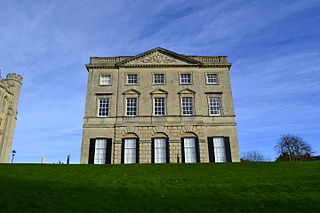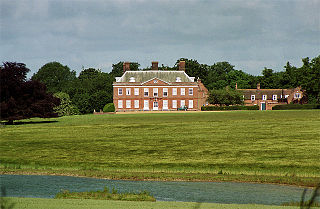
Sheringham is a seaside town and civil parish in the county of Norfolk, England. The motto of the town, granted in 1953 to the Sheringham Urban District Council, is Mare Ditat Pinusque Decorat, Latin for "The sea enriches and the pine adorns".

Sheringham Park is a landscape park and gardens near the town of Sheringham, Norfolk, England. The park surrounds Sheringham Hall, lying mostly to its south. The hall is privately owned on a long leasehold. The plantations of Sheringham Park are in the care of the National Trust and open to visitors. National Trust members and guests have no rights of access across the park and farmland surrounding Sheringham Hall. Access is solely at the discretion of the owners of George Youngs (Farms) Ltd which farms the Sheringham estate and who also own the long leasehold of Sheringham Hall.

Blickling Hall is a Jacobean stately home situated in 5,000 acres of parkland in a loop of the River Bure, near the village of Blickling north of Aylsham in Norfolk, England. The mansion was built on the ruins of a Tudor building for Sir Henry Hobart from 1616 and designed by Robert Lyminge. The library at Blickling Hall contains one of the most historically significant collections of manuscripts and books in England, containing an estimated 13,000 to 14,000 volumes. The core collection was formed by Sir Richard Ellys. The property passed into the care of the National Trust in 1940.

Humphry Repton was the last great designer of the classic phase of the English landscape garden, often regarded as the successor to Capability Brown. His style is thought of as the precursor of the more intricate and eclectic styles of the 19th century. His first name is often incorrectly spelt "Humphrey".

Ashton Court is a mansion house and estate to the west of Bristol in England. Although the estate lies mainly in North Somerset, it is owned by the City of Bristol. The mansion and stables are a Grade I listed building. Other structures on the estate are also listed.

Beaudesert was an estate and stately home on the southern edge of Cannock Chase in Staffordshire. It was one of the family seats of the Paget family, the Marquesses of Anglesey. The estate was obtained by William Paget, 1st Baron Paget in 1546; the family's other main seat is at Plas Newydd.

Holkham Hall is an 18th-century country house near the village of Holkham, Norfolk, England, constructed in the Neo-Palladian style for the 1st Earl of Leicester by the architect William Kent, aided by Lord Burlington.

Wolterton Hall, is a large country house in the ecclesiastical parish of Wickmere with Wolterton and the civil parish of Wickmere in the county of Norfolk, England, United Kingdom. The present hall was commissioned by the 1st Baron Walpole of Wolterton and completed in 1742, it was designed by the architect Thomas Ripley who was a protégé of Lord Walpole and his brother Sir Robert Walpole.

Honing is a village and a civil parish in the English county of Norfolk. The village is 15 miles (24 km) north-northeast of Norwich, 13 miles (21 km) south east of Cromer and 4 miles (6.4 km) east of North Walsham.

Matlaske is a village and a civil parish in the English county of Norfolk. The village is 21.6 miles (34.8 km) North-north-west of Norwich, 9.3 miles (15.0 km) south-west of Cromer and 136 miles (219 km) north-north-east of London. The nearest railway station is at Sheringham for the Bittern Line which runs between Sheringham, Cromer and Norwich. The nearest airport is Norwich International Airport. The parish of Matlask in the 2001 census, a population of 124, increasing to 139 at the 2011 Census. For the purposes of local government, the parish falls within the district of North Norfolk.

Wickmere is a village and a civil parish in the English county of Norfolk, 18.9 miles (30.4 km) north of Norwich, 7.3 miles (11.7 km) south-southwest of Cromer and 132 miles (212 km) northeast of London. The nearest railway station is at Gunton for the Bittern Line which runs between Sheringham, Cromer and Norwich. The nearest airport is Norwich International Airport. In the 2001 census it had a population of 125, which increased to 158 at the 2011 census. For the purposes of local government, the it falls within the district of North Norfolk.

Stanage Park is a Grade II* listed Welsh country house set in a large park located some 3 miles (4.8 km) east of Knighton, Powys near the settlement of Heartsease. The extensive parkland and the house were laid out by Humphry Repton and his son, John Adey Repton, in the early nineteenth century. Repton's picturesque parkland improvements, castellated house and enclosed garden survive almost intact. The estate is the last and most complete of his three recognized Welsh landscape commissions.

The Royal Fort House is a historic house in Tyndalls Park, Bristol. The building currently houses the University of Bristol's Faculty of Science offices, the Brigstow Institute, Elizabeth Blackwell Institute for Health Research, the Cabot Institute and the Jean Golding Institute for data-intensive research.

Sheringham Lifeboat Station is an RNLI operated lifeboat station located in the town of Sheringham in the English county of Norfolk. Since 1992, the station has been inshore operations only - currently with an Atlantic 85 rigid inflatable - offshore lifeboats are to the east at Cromer and the west at Wells-next-the-sea.

Endsleigh Cottage is a country house near Milton Abbot, about 6 miles NW of Tavistock, Devon in England. It is a Grade I listed building. The gardens are Grade I listed in the National Register of Historic Parks and Gardens. The house was built in the early 19th century for the Duke of Bedford. Today, it is a hotel.

Buckhurst Park is an English country house and landscaped park in Withyham, East Sussex. It is the seat of William Sackville, 11th Earl De La Warr.

Hanworth Hall is a large late 17th-century country house some 500 m to the south of the village of Hanworth, Norfolk, England. It is protected and recognised in the highest category of the three in the English statutory scheme, as a Grade I listed building.

Barningham Hall is a Grade I listed building which stands in the grounds of the estate called Barningham Winter. Both the hall and estate privately owned. The house is close to the village of Matlask in the English County of Norfolk in the United Kingdom. The house was built for Sir Edward Paston in 1612 although the house seen today is the result of renovations, alterations and enlargement carried out under the control and design of Humphry Repton and his architect son John Adey Repton in 1805.

Honing Hall is a Grade II* listed building which stands in a small estate close to the village of Honing in the English county of Norfolk within the United Kingdom. It was built in 1748 for a wealthy Worstead weaver called Andrew Chamber.

A game larder, also sometimes known as a deer or venison larder, deer, venison or game house, game pantry or game store, is a small domestic outbuilding where the carcasses of game, including deer, game birds, hares and rabbits, are hung to mature in a cool environment. A feature of large country houses and sporting lodges in Britain and parts of northern Europe from the 18th century, game larders continue to be used by shooting estates.

























